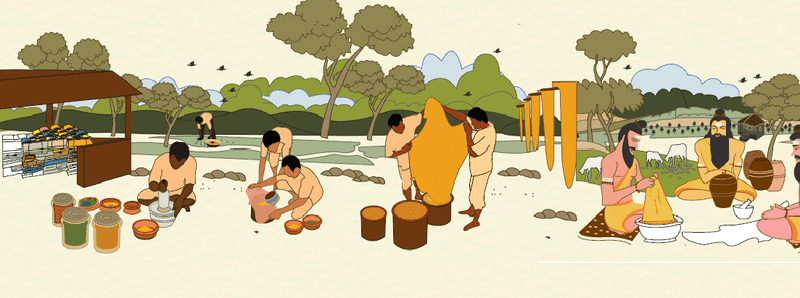TRADITIONAL HISTORY

According to the history, clothing as means to protect and heal goes back to the Rigveda, an ancient and sacred Hindu text composed of Ayurvedic scriptures, Charaka Samhita and . Until about 100 years ago, they said, people in many parts of India were still using various forms of natural dyeing, in which people repeatedly dipped their clothing in an herb-based preparation after each wash.
People in India have also used plants for coloring fabric during the annual festival of colors, known as Holi because the dyes are close to nature and toxicity free. At some point use after use, wash after wash, dipping after dipping the color and value would hold. But it was seen just as another part of living harmoniously with the environment. Ayurvastra is not referred to in the ancient or contemporary classics of Ayurveda. Instead, some references mention-certain plants that have a therapeutic result when applied to the skin, even without concurrent oral administration, by working through a mode of action called ‘Prabhav’ which means effect.
AYURVASTRA – A HEALING HERB-DYED CLOTH
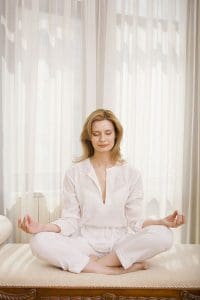
Ayurvastra is an ancient technique of dyeing textiles using medicinal herbs. The concept of Ayurvastra was practiced in India before the industrialization of the textile industry. Even today, in some parts of south India, ayurvedic herbal dyed clothes are used to carry a newborn child, which will act as an antibacterial barrier for the child. There is evidence that these cloths were used as a medium for ayurvedic treatment, as the skin received the medicinal benefits of these herbs through the exposure to clothing, bedding, or coir mats.
The Ayurvastra concept was revived through a project submitted to The Government of Kerala, South India, by a Weavers Society in Kerala and further developed and researched by the Ayurveda University of Kerala. Since 1992 the Weavers Society has been refining the ayurvastra technique to make eco-fabrics suitable for modern use and to create different colors depending on the plants or herbs used for various health benefits. Ayurvastra fabrics are 100% organic, completely free of synthetic chemicals, toxic irritants, and are biodegradable. This is why ayurvastra cloth is often used for sleepwear, bed sheets, towels, meditation clothes, and cotton mats.
AYURVASTRA WORKS

As the body’s largest organ, the skin functions as a protective barrier but also as a conduit for outside substances to enter the body. In the same way that the skin may absorb environmental toxins and chemicals from conventional clothing, it has the ability to absorb herbs found in our natural dyes. These herbs release their medicinal qualities into the body and strengthen the skin’s ability to block and resist harmful substances.
AYURVASTRA IMPROVING HEALTH

The micro-encapsulation technology that embeds tiny capsules into clothing fabrics, when these tiny microcapsules come into contact with body heat and wear, they slowly release their chemical payloads which can contain fragrances or skincare lotions or other chemicals which might have some topical beauty or medicinal value to the skin that comes into contact with the micro-encapsulated fabric.
The use of fabrics and garments to deliver health solutions is actually a very old concept called Ayurvastra. Ayurvastra is a branch of Ayurveda, the ancient 5,000-year-old Indian system of Vedic healthcare. Loosely translated, ‘Ayur’ is Sanskrit for health, ‘Veda’ means wisdom, and ‘vastra’ is cloth or clothing.
Ayurvastra clothing is made from organic cotton fabric that has been permeated with special herbs and oils that promote health and cure special diseases depending upon the blends of embedded herbs and oils.
Ayurvastra clothing is believed to help restore balance within the body’s systems and strengthen the immune system. Ayurvastra cloth is completely free of synthetic chemicals and toxic irritants and is totally organic, sustainable, and biodegradable. Every step in the preparation of ayurvastra cloth and clothing is carefully and precisely controlled.
The organic cotton yarn or fabric is then dyed in a carefully controlled mixture of herbal dyes depending upon the disease or ailment being treated. Dyes for Ayurvastra cloth typically contain between 40 and 60 specifically blended and carefully prepared medicinal herbs, plants, flowers, roots, and barks.
The temperatures of the dyes, the duration and number of the dye soaks, the blend of herbs, and even the equipment used are carefully controlled. Environmentally friendly processes are adopted for making ayurvastra cloth and clothing, in which the entire process is organic. The cloth is bleached with cow’s urine, which has high medicinal value.

Many Ayurvedic doctors consider cow’s urine to be highly beneficial in balancing an individual’s ‘doshas’ or basic constituents of an individual’s physiology and psychology, strengthening the immune systems and as an elixir in giving life.
By coming in contact with ayurvastra, the body loses toxins and its metabolism is enhanced. For preparations of coir mats, the fibers are soaked in Ayurvastradyesand then woven into coir mats. Ayurvastra cloth is also being used for sarees or saris, the traditional flowing dress of Indian women, and in purdahs or pardaas.
The spread of Ayurvastra and Ayurveda into other cultures and regions of the world express the growing interest in more traditional and natural healthcare systems that are based upon restoring balance and health through natural methods rather than through Western medicines.
DESIGNER PROMOTING AYURVASTRA

AYURVASTRA ONLINE HAVE STARTED TO OFFER PRODUCTS OVER THE INTERNET.
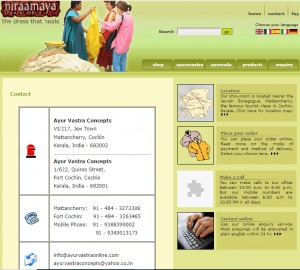

COLOURS PRODUCED BY DIFFERENT HERBS

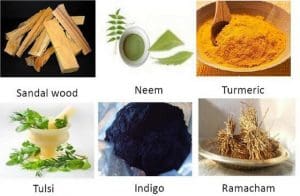
- Red – Sandalwood (Santalum album), Safflower (Carthamus tinctorius), Madder Root (Rubia tinctorium)
- Blue – Indigo (Indigofera tinctoria), Woad (Isatis tinctoria), Sunt berry (Acacia nilotica), Pivet (Ligustrum vulgare)
- Yellow – Pomegranate rind (Punica granatum), Turmeric (Curcuma longa), Marigold (Marigold tagetes), Saffron (Crocus sativus), Goldenrod (Solidago Grandis), Teak (Tectona grandis)
- Orange – Safflower (Carthamus tinctorius), Madder Root (Rubia tinctorum), Marigold (Marigold tagetes), Annota (Bixa Orellana), Lily (Convallaria majalis)
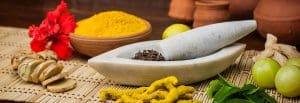
- Green – Pomegranate (Punica granatum), Indigo (Indigofera tinctoria), Neem (Azadirachta indica), Amaltas (Cassia fistula), Turmeric (Curcuma longa)
- Brown – Black cutch (Acacia catechu), Henna (Lawsonia Inermis)
- Black – Iron Scrap, Jaggery (Saccharum officinarum), Peanut Oil (Arachis hypogaea), Castor oil (Ricinus Communis)
DISEASES CURED BY DIFFERENT HERBS
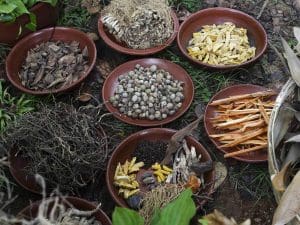
- Arthritis – Curry leaves (Murraya koenigii), Agathi (Sesbania grandiflora) and Manjishta (Rubia cordifolia)
- Diabetes – Touch-me-not (Mimosa pudica), Methi (Trigonella foenum-graecum), Gurhal (Hibiscus rosa Sinensis), Turmeric (Curcuma longa), Jamun (Syzygium cumini), Mahuva (Madhuca longifolia), Cumon/cumin seeds (Cuminum Cyminum), Champa flower (Magnolia champaca) and Shoe flower (Hibiscus rosa-Sinensis)
- Skin diseases – Turmeric (Curcuma longa), Korphad (Aloe vera), Brajil wood (Caesalpinia echinata), Neem (Azadirachta indica), Castor (Ricinus Communis), Sandalwood (Santalum album) and Indigo (Indigofera tinctoria), Amla (Emblica Officinalis), Henna (Lawsonia inermis)
- Hypertension – Basil (Ocimum basilicum), Baheda (Terminalia bellirica), Harad (Terminalia chebula), Methi (Trigonella foenum-graecum), Guar (Cyamopsis tetragonoloba), Indigo (Indigofera tinctoria), Anar (Punica granatum), Safflower (Carthamus tinctorius) and Myrobalan (Terminalia chebula)
- Anemia – Korphad (Aloe vera), Baheda, Myrobalan (Terminalia chebula), Chireta/Chirayata (Swertia chirata), Champa (Magnolia champaca), Punamava (Boerhaavia diffusa), and Turmeric (Curcuma longa)

- Asthma – Erandi (Ricinus communis), Basil (Ocimum basilicum), Malabar Nut (Adhatoda Vasica Nees), Vallipala (Tylophora Indica), Myrobolon (Terminalia chebula), Arjun (Terminalia arjuna)
- Psoriasis – Turmeric (Curcuma longa), nirgandi (Vitex negundo), amaltas (Cassia fistula), cluster fig (Ficus racemosa), karanj (Pongamia pinnata), black nightshade (Solanum nigrum)
- Sleeplessness – Cuscus/Khus-Khus (Vetiveria zizanoides)
- Headache – Sandalwood (Santalum album)
- Rheumatism – Indian Borage (Trichoderma Indicum), Ajowan (Trachyspermum Ammi), Reetha (Sapindus trifoliatus), Messina Creeper (Ipomoea cairica)
- Leprosy – Manjistha (Rubia Cordifolia)
- HIV AIDS – Korphad (Aloe vera), Basil (Ocimum basilicum), Indian Mulberry (Morinda pubescens), Turmeric (Curcuma longa), Winter Cherry (Withania somnifera)
AYURVASTRA – DYEING PROCESS

Processing refers to the series of operations performed in making a product. During the making of Ayurvastra, around 200 herbs have been reported to be used for developing various effects and colors in cloth. Each color is produced from a preparation that typically contains one or more pre-dominant herbs (like turmeric in our turmeric clothing) along with 40 or more others, that are specifically blended and carefully prepared medicinal herbs from plants’ flowers, roots, barks, etc
Different processes are followed depending on whether raw woven fabric or yarn is being dyed. For handloom, the process starts with the cotton yarn and goes through a process named de-sizing (to remove loose particles, debris, etc.). The common processes used in the manufacturing of Ayurvastra are as follows:
Bleaching

The selected fabric or yarn is first bleached using a preparation based on cow urine. Cows pasture naturally and also feed on 3 different types of medicinal grass. Many ayurvedic doctors consider cow’s urine to be highly beneficial in balancing an individual’s “doshas” or basic constituents of an individual’s physiology and psychology, strengthening the immune systems and as an elixir in giving life. The fabric or yarn is also exposed to direct sunlight as part of the process.
Gumming

To make the colors bright and fast a number, the proprietary gumming process is used before dyeing that includes plants like Lodhra (Symplocos racemosa), Kenduka (Diospyros ebenum), and fruit extracts of Haritaki (Terminalia chebula), etc. Each color/dye requires its
AYURVASTRA MANUFACTURES ECO-FRIENDLY CLOTHS
Ayurvastra aims at manufacturing 100 percent organic and chemical-free fabrics and attires. By doing this Ayurvastra protects the planet’s natural resources from the clutches of harmful toxic chemical wastes used in the production of agriculture and textiles. It also aims at reviving the ancient Ayurvedic dyeing technology in its fabrics.
The medicinal herbs include turmeric, tulsi, neem, khus-khus (vetiver), sandalwood, and indigo. Further all these herbs are blended with balancing herbs to make delicate colors that remain everlastingly in the fibers. Ayurvastra dyeing is applied to all-natural fibers like
cotton, silk, linen, wool, coir, hemp, nettle, bamboo to make eco-friendly textiles. Each herb caters a different medicinal property.
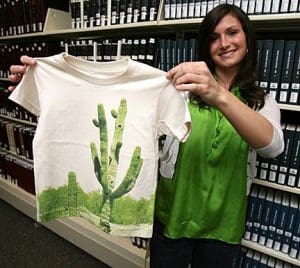
Likewise a fabric with the properties of tulsi helps fight against allergies and toxins and turmeric, which has anti-inflammatory and anti-bacterial properties protects against skin infections. In order to produce Ayurvastra fabrics, the cloth is instilled into a specially prepared AyurvedicKasayam containing more than 30 herbs.
The herbal properties from these fabrics are then released on the body by preventing various infections and diseases. Ayuvastra fabrics were also experimented on patients suffering from diseases like eczema, psoriasis and rheumatism which showed progress in them.
AYURVASTRA IS THE DOCTOR OF THE FUTURE
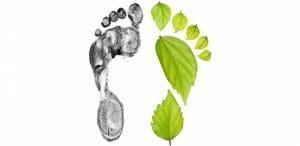
The doctor of the future will give no medicine but will interest his patients in the care of the human frame, in diet, and in the cause and prevention of disease. Two of the oldest sciences known to mankind come together. It’s the amalgamation of Ayurveda- the science of increasing the longevity of a person and making fabric textiles. Man has used textiles
from a very early period in various forms like ropes; clothes, etc. but in general textiles to the layman is fabric.
The unlikely yet amazing combination of these two sciences has resulted in Ayurvastra. Ayurvastra, the name given to a whole new concept of natural clothing, has the fabric yarns infused with plant extracts and herbs. Developed under the aegis of The Handloom Weavers Development Society anon-profit organization, Ayurvastra claims to rid people of many diseases by regular use of these clothes.
HERBAL PRODUCTS
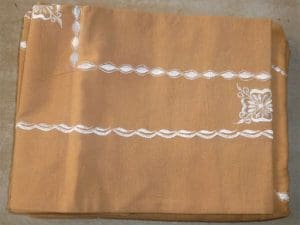

- Cotton – Bedsheets, nightdresses for kids men and women, Dyed fabrics for any textile material
- Silk – Beds sheets, nightdresses for kid’s men and women, Dyed fabrics for any textile material.
- Wool – Yoga mats and prayer mats, Dyed fabrics for any textile material.
- Jute – Yoga mats and prayer mats or with mixed yarn
- Coir – Carpets, Rugs,
- Handloom – Dhotis, Shawls, etc
- Packing -Each of the above products are packed in eco-friendly gift
MARKET POTENTIAL

- Chemical dyes used in the textile industry have impact on human immune
- Chemical contents in textiles play a major role in the degradation of human skin, absorbs deep into the human system causing various health problems.
- As Ayurvastra materials are totally chemical-free and environment friendly the huge impact it can have in the textile industry is beyond explanation.
- Ayurvastra products not only prevent the diseases but also perk up the immune system in human
- A healthy world with an earthy remedy.
- This is a unique technology and thereby opening up a new area of entrepreneurship, job orientation and economic stability.
WORKING PRINCIPLE OF AYURVASTRA
- Herbal dyeing without chemical
- Protect human skin from many diseases by body transpiration
- Skin comes in contact with “Ayurvastra”, body losses toxins &itsmetabolismenhanced
- Absorption of the drug through skin is a passive process i.e through the barrier
- The most effective time to wear ayurvastra is during sleep or
PREPARATION OF AYURVASTRA
- Need 100% organic cotton, hand-loomed.
- Herbal dyes depending upon the disease are used.
- For diabetes, Mimosa pudica (touch-me-not), cumin or cumin seeds, Champa flower and shoe flower are combined in
- For skin diseases, the herbs used are turmeric, neem and sandalwood.
CONCLUSION

Scope of Ayurvastra is endless and it is the way to keep people healthy. Ayurvastra principal is used to maintaining good health and adopt a healthy way of life. Ayurvastra has been receiving increased awareness from many parts of the world. National government ministries and state governments within India consider.
Ayurvastra as a way to revitalize and increase the market for their handloom industries and to create a niche for their eco-friendly handloom fabrics. The team in India hopes the partnership will help build a platform for education on ayurvastra as an alternative to synthetic and synthetically dyed fabrics, and to increase business that results in a stable economy providing a livelihood for hundreds of people.
REFERENCE
https://www.researchgate.net/publication/272771234_Ayurvastra_Herbal_couture_technology_in_textile
https://www.sustainabletextiles.club/ayurvastra-information
https://www.fibre2fashion.com/industry-article/6693/ayurvastra-an-eco-friendly-textile
https://www.researchgate.net/publication/282455304_Ayurvastra_A_miracle_mediherbal_cloth

Article written by Swati Patali B.Sc in Textile and Apparel Designing from Sir Vithaldas Thackersey College of Home Science. Textile Value Chain intern.

